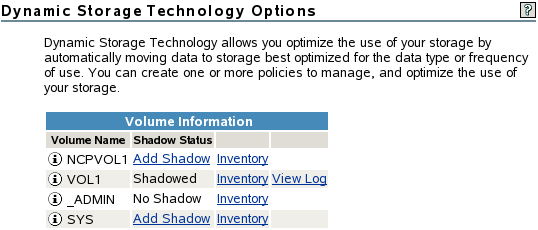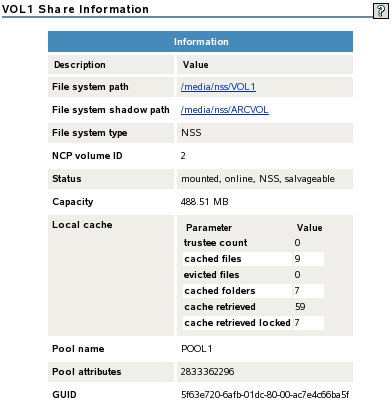10.9 Viewing Information about a Shadow Volume
In Novell Remote Manager on the Dynamic Storage Technology Options page, the Volume Information report (as shown in Figure 10-1) contains information about all NCP volumes on the server. This includes NSS volumes (which are by default NCP volumes) and NCP shares on Linux POSIX file systems such as Ext3, Reiser, and XFS.
IMPORTANT:DST supports NSS volumes to be used in shadow volumes at this time.
Figure 10-1 Volume Information Report

The report does not distinguish between the underlying file systems for the NCP volumes. Ensure that you create shadows only for NCP volumes based on the NSS file system. You can identify whether a volume is an NSS volume by clicking the Information icon next to the volume name, then viewing its underlying file system type.
To understand the information provided in the report, see the following sections:
10.9.1 Accessing the Volume Information Report
-
Open Novell Remote Manager, then log in as the root user.
-
Select View File System > Dynamic Storage Technology Options to open the Volume Information report.
10.9.2 Viewing the Shadow Status of a Volume
In the Volume Information report, the Shadow Status column displays whether or not a volume has a shadow. There are three states:
Table 10-2 Shadow Status in the Volume Information Report
|
Shadow State |
Description |
|---|---|
|
No Shadow |
The NSS _ADMIN volume cannot be shadowed, and displays a status of No Shadow. |
|
Add Shadow |
The volume is an NSS volume or an NCP volume that is eligible for shadowing. You must separately verify that the volume satisfies the guidelines and caveats that are specified in Section 9.0, Planning for DST Shadow Volume Pairs and Policies. IMPORTANT:Select the Add Shadow link only for NCP volumes where the underlying file system is the NSS file system. |
|
Shadowed |
The volume is the primary volume in a DST shadow volume. To identify the secondary storage area for this volume, click the Information icon next to the volume name to go to the Share Information page, then view the File System Shadow Path. |
10.9.3 Viewing the Share Information for a Shadow Volume
The Share Information page displays details about the NCP volume, such as its Linux file system path, the file system path of its shadow area (if it is shadowed), the file system type, and capacity.
Figure 10-2 NCP Volume Share Information

Table 10-3 describes each of the reported parameters on the Share Information page:
Table 10-3 NCP Volume Share Information
|
Parameter |
Description |
|---|---|
|
File System Path |
The mount point of the selected volume. |
|
File System Shadow Path |
If the selected volume is shadowed, this is the mount point of its secondary storage area. |
|
File System Type |
The underlying file system type, such as NSS, Ext3, Reiser, or XFS. |
|
NCP Volume ID |
The unique identifier given to the volume by the NCP engine. Values range between 0 and 254 (up to 255 volumes mounted concurrently). When the primary volume has a state of Shadowed, its NCP volume ID represents the DST shadow volume pair of volumes. There is not a separate NCP volume ID assigned to the secondary volume while it is in the shadow volume relationship. |
|
Status |
The status of the selected volume, such as if it is mounted and online or offline for the NCP engine. For NSS volumes, it also shows which attributes are enabled, such as user quotas, directory quotas, and salvage. |
|
Capacity |
The total amount of space allocated to the volume. |
|
Advanced Information |
Click View to reveal the following information: Local Cache: Shows the current status of cache parameters, such as trustee count, cached files, evicted files, cached folders, cache retrieved, and cache retrieved locked. Pool Name: For NSS, the name of the NSS pool where the volume resides. Pool Attributes: For NSS, the attribute identifier for the volume’s pool. GUID: The eDirectory globally unique identifier for the selected volume. |
|
Open Files |
Reports the connection number (station) of the NCP client connection, the typeless fully distinguished eDirectory user name (such as username.context) who opened the connection, and the files that are currently open for that connection. You manage NCP connections to the primary storage area of the DST shadow volume. Users do not connect directly to the secondary storage area. To manage connections, go to the Manage NCP Services role, then click Manage Connections. |